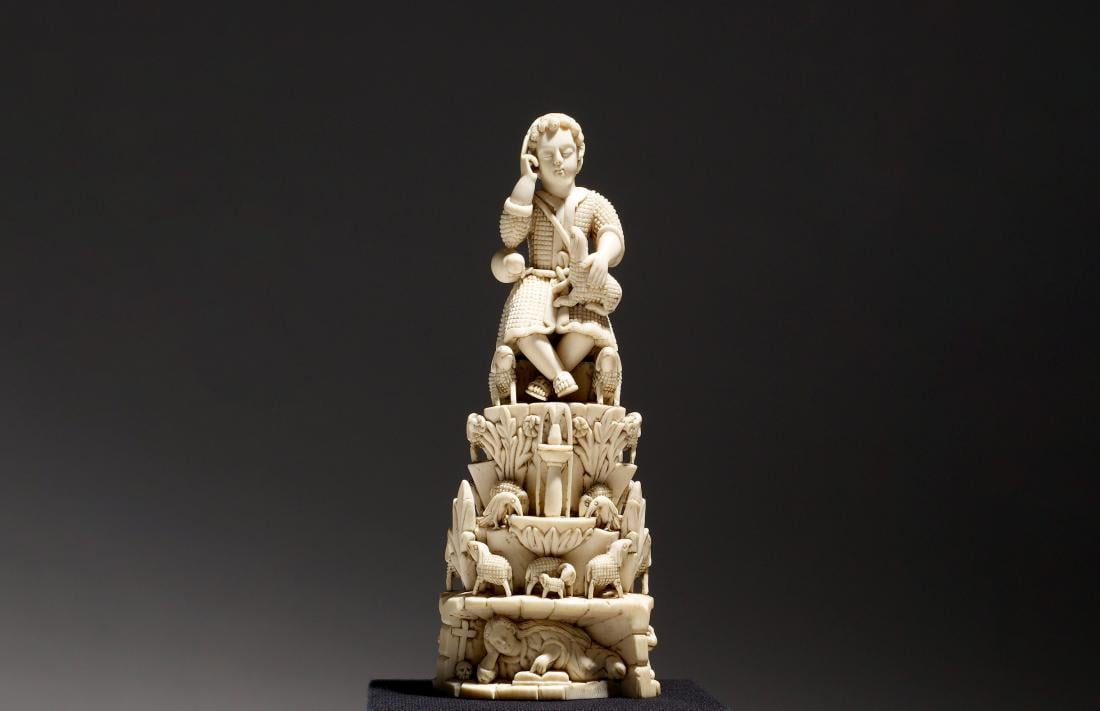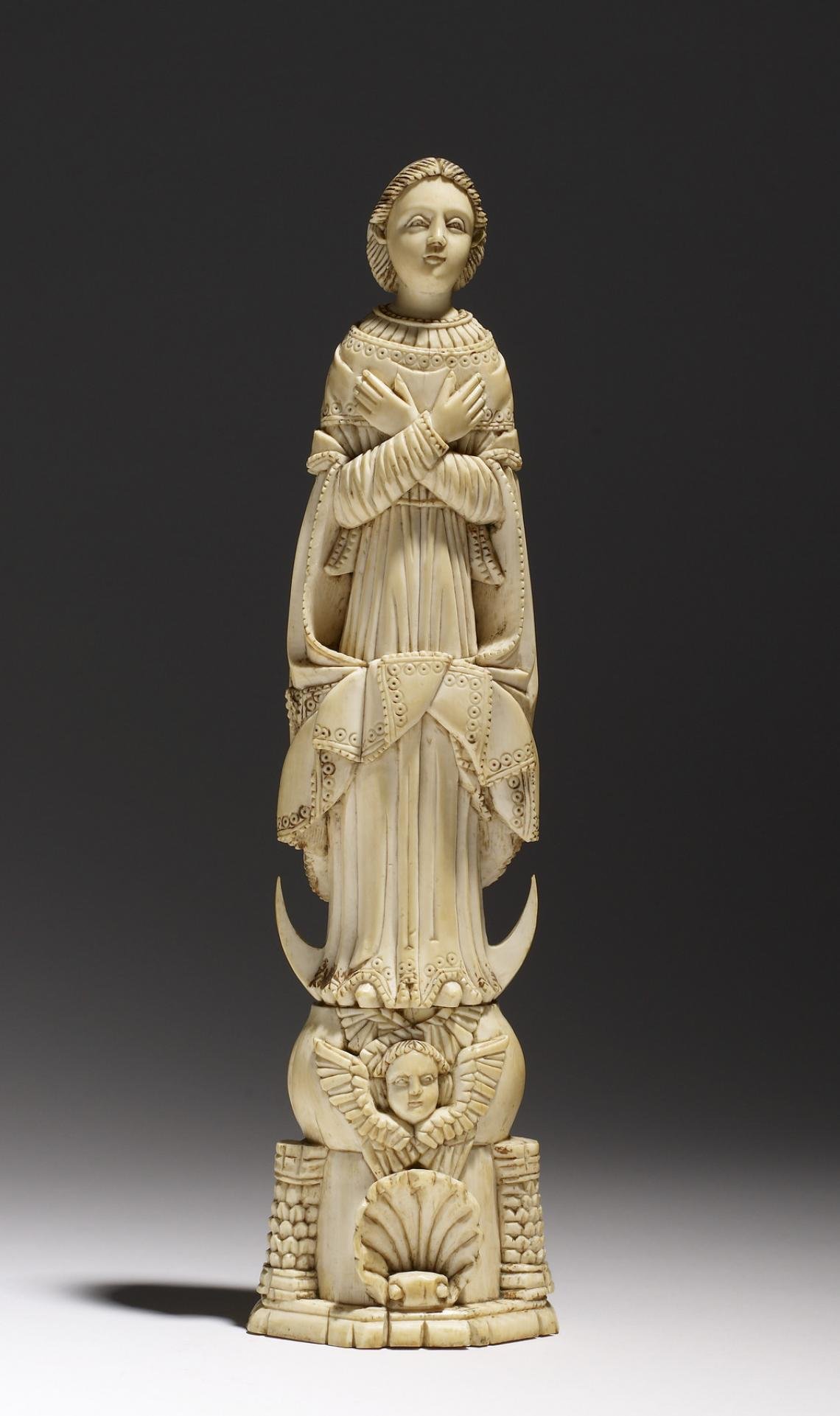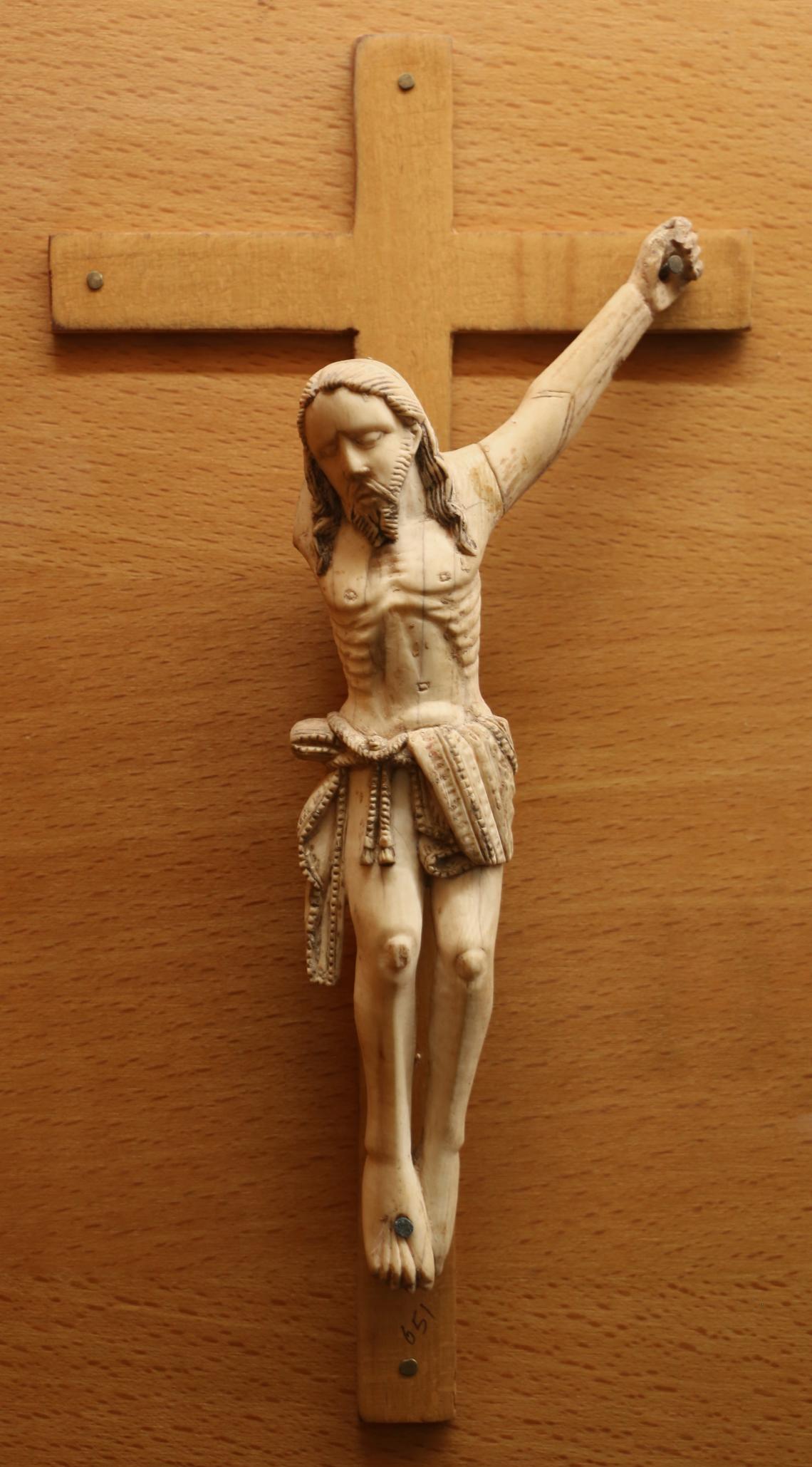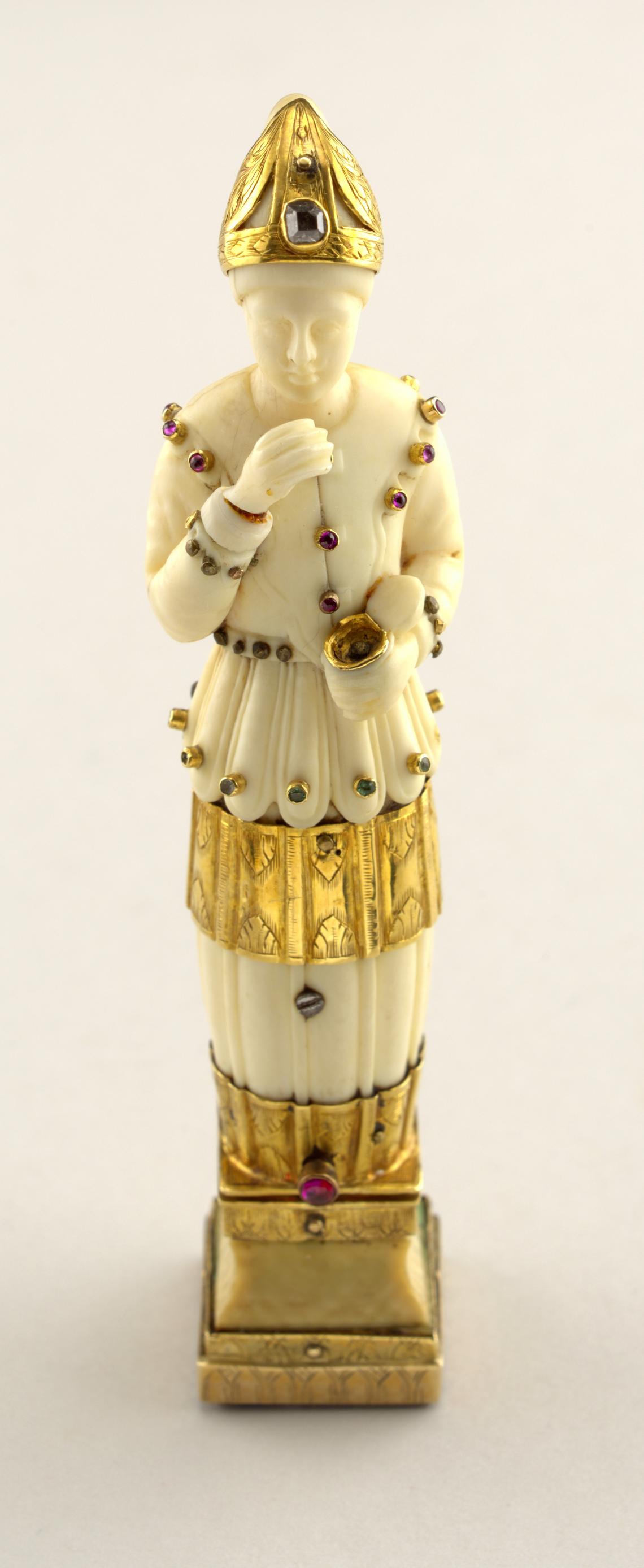The Christ Child as Good Shepherd, Goa, India, 17th century, Ivory, 17.4 × 6.8 × 5 cm.
Made in colonial Goa in the sixteenth and seventeenth centuries, ivory statuettes are devotional objects of varying sizes that form a unique genre of Goan Christian iconography. Ranging from a few inches to more than a foot in height, these statuettes were made in large quantities for local evangelism and export, using ivory sourced from Portugal’s East African enclaves. They are significant for their combination of European Christian iconography with stylistic treatments native to the religions and art of the ancient Indian subcontinent, such as elements from the Shilpa Shastras and Buddhist art.
Madonna of the Immaculate Conception, Goa, India, 1680–1700, Ivory with gilding and paint, 26.1 × 7 × 5.4 cm.
Following the arrival of their first armada in Calicut with Vasco da Gama in 1498, the Portuguese set up an enclave at Goa on the southwestern coast of India, strategically locating themselves for their international trade in Malabar spices. They also aimed to spread the gospel of Christianity, with its values and religious ideas, to the mostly Hindu population of the region. Through the sixteenth century, many Christian missionaries arrived here, beginning with the Franciscans in 1510, followed by the Jesuits in 1542, the Dominicans in 1548, the Augustinians in 1572, and finally the Carmelites and the Theatines in the seventeenth century. While regions of Malabar, Gujarat and Ceylon (present-day Sri Lanka) were already engaged in ivory trade and carving before the Portuguese arrived, the scale of production was small, seen mainly in bangles made for brides from wealthy upper caste families. Under the direction of Portuguese missionaries, large quantities of ivory sourced from their East African colonies came to be used to carve ecclesiastical statuettes at local workshops by indigenous artisans. Art and artefacts played a pivotal role in their endeavour to disseminate the Christian faith. They built churches and directed local artisans in the making of thousands of Catholic images in wood and ivory — some in large sizes for walls and altars, others small and compact to serve as portable icons that the evangelists could distribute.
The Jesuits in particular approached the making of such artefacts in a spirit of collaboration with the local population. While they brought iconographic images from Europe to serve as references for the indigenous artisans, most commonly in the form of prints, they welcomed stylistic interpretations from the existing cultures of India. This led to the distinctive rendering of common figures such as Jesus, Mary and the Christian saints in sculptural styles local to the subcontinent, drawing from ancient treatises such as the Shilpa Shastras as well as Hindu, Buddhist and Jain religious images. Various Jesuit missions also recorded the production of Christian statuettes in ivory in the imperial workshops of the Mughal emperor Akbar around 1580–1595.
Portuguese Crucifix from the collections of the Archaeological Museum and Portrait Gallery (Old Goa), Photographer: Sailco, Goa, India, 2019, Ivory.
With individuals or groups as their subjects, these images depicted a range of themes, such as the birth of Jesus, the Passion of Christ and other important events from the Gospel. Most popular among these were the Good Shepherd and the Crucifixion of Christ, as well as the Virgin Mary and Child. Inspired by Reformation images of the Immaculate Conception, the latter show Mary standing in the Saviour pose and clutching rosary beads in her hand. She is often depicted standing atop a crescent moon and dragon, motifs from the Book of the Apocalypse in the New Testament. The influence of Indian traditions can be seen in the treatment of the drapery, which is often rigid, as well as other details, such as the rendering of her hair in waves and curls. Other common subjects included Mary Magdalene, John the Baptist, Francis of Assisi, Ignatius of Loyola and other saints who are directly linked to the enterprise of establishing colonies and carrying out missionary work for the Catholic Church.
Seal, India, Ivory, gold, stone, diamond, lapiz lazuli, 10.2 x 1.8 x 1.8 cm.
The iconography of the Christ Child as the Good Shepherd that emerged in these statuettes is unique, having no precedent in Christian art. The main figure of the Christ Child is depicted as sitting atop a tiered structure resembling a rocky outcrop, which is often ornamented with indigenous flora and fauna. The bottom-most section shows Mary Magdalene or another saint, such as John the Evangelist, reclining in a cave-like niche and reading the holy scriptures. The next tier usually depicts a fountain — signifying baptism and/or eucharist — often surrounded by doves and lambs. At the top of this formation is a young figure of Christ: besides being surrounded by sheep, his identity as a shepherd is indicated through his woollen coat, the water gourd tucked underneath his right elbow and a small pouch slung across his shoulder. Generally thought to be contemplating his eventual sacrifice for humanity, he is depicted seated in a meditative posture; at times he is seen carrying lambs on his shoulders or in his lap, reinforcing the metaphor of sacrifice. His eyes are closed and expression serene, as in Buddha images, while his right hand gently touches his inclined head with two fingers — a gesture that recalls the pensive bodhisattva iconography common in sixth and seventh century East Asia; his ankles are crossed in a relaxed manner, reminiscent of earlier Gandharan bodhisattva images. His childlike features and form draw heavily from the iconography of Hindu gods such as child Krishna. The vertical, tiered mountain form of this figural type recalls the towers and superstructures of Hindu temples and stands in contrast against the typically horizontal representation of such themes in European traditions. The treatment of the sheep in relation to the Christ figure can be compared to the representation of the vahanas that accompany Hindu deities, such as the bull with Durga and the tiger accompanying Shiva in Hindu artistic traditions. The Good Shepherd rockery images thus form a good example of the Goan statuettes’ unique combination of European and Catholic imagery with typically South Asian elements.
Their distinctive compositional and aesthetic typology combined with their expensive medium made these ivory statuettes exclusive and valuable, and they were often used as diplomatic gifts for rulers and elites. Today these statuettes are preserved in collections worldwide, including those of the Salar Jung Museum, Hyderabad; the Pilar Museum, Goa; the British Museum and Victoria and Albert Museum in London; and the Walters Art Museum in Baltimore, Maryland.
This article first appeared in the MAP Academy Encyclopedia of Art.
The MAP Academy is a non-profit online platform consisting of an Encyclopedia of Art, Courses and Stories, that encourages knowledge building and engagement with the visual arts and histories of South Asia. Our team of researchers, editors, writers and creatives are united by a shared goal of creating more equitable resources for the study of art histories from the region.






